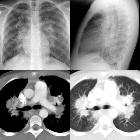chronic granulomatous disease

Chronic granulomatous disease (CGD) refers to a heterogeneous group of inherited immune deficiency disorders characterized by the inability to destroy phagocytosed catalase-positive bacteria due to a lack of NADPH oxidase which results in formation of granulomas in different tissues.
Epidemiology
Its reported prevalence is around 1:200,000-250,000. The disease typically precipitates in the first few years of life.
Clinical presentation
The most common presentation is a young patient with short stature, dermatitis, gingivitis, anemia of chronic disease, recurrent lymphadenopathy, hepatosplenomegaly, hepatic abscesses and multifocal, recurrent osteomyelitis.
Pathology
It occurs due to a defective nicotinamide adenine dinucleotide phosphate (NADPH) oxidase in phagocytes. This then results in deficient production of the oxygen radicals needed by phagocytes for intracellular killing of microorganisms in particular catalase-positive bacterias such as S.aureus, Serratia, Klebsiella, Burkholderia, and Aspergillus . It can affect multiple systems although the respiratory system and bones are the most commonly affected. The organ systems that can potentially get affected include lymphatic, hepatic, skeletal, gastrointestinal, genitourinary, head and neck, and central nervous system . Diagnosis is by the nitroblue tetrazolium (NBT) slide test, cytometry, or cytochrome C reduction.
The characteristic manifestation of chronic granulomatous disease is recurrent bacterial and fungal infections.
Genetics
Various inheritance forms have been described which include X-linked recessive (most common and tends to have a most severe clinical phenotype) and autosomal recessive .
Radiographic features
Imaging findings will depend on the system involved. Multifocal and recurrent unusual osteomyelitis, recurrent hepatic abscesses, hepatosplenomegaly, and lymphadenitis. For lung involvement see - pulmonary manifestations of chronic granulomatous disease.
Treatment and prognosis
Prophylaxis with daily trimethoprim-sulfamethoxazole and gamma interferon three times a week. Bone marrow transplantation is curative.
History and etymology
It was thought to have been first described by American pediatrician and epidemiologist Heinz Berendes (1925-1999) et al. in 1957.
Siehe auch:
und weiter:

 Assoziationen und Differentialdiagnosen zu chronic granulomatous disease:
Assoziationen und Differentialdiagnosen zu chronic granulomatous disease:

